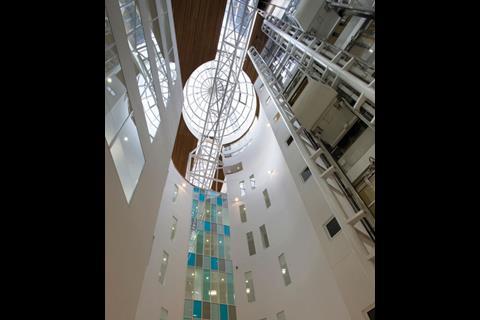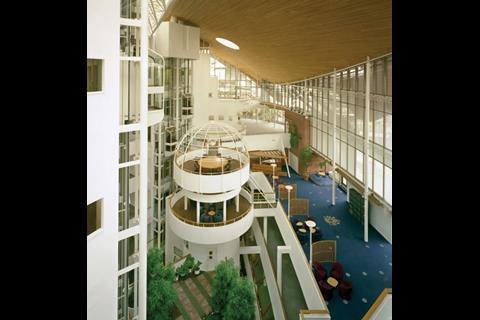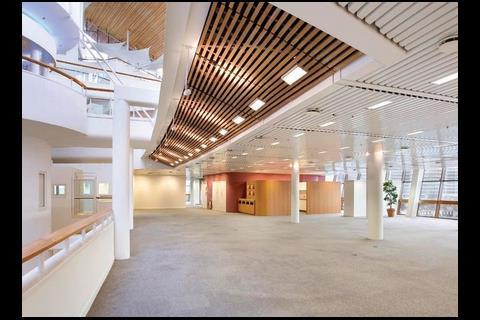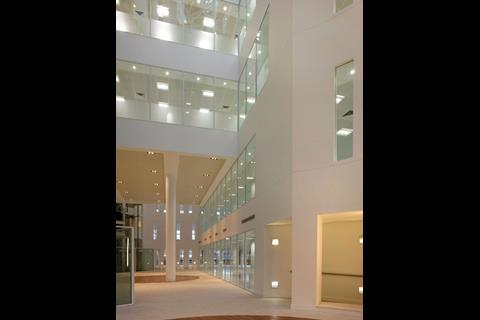Ralph Erskine’s Ark is one of London’s most striking landmarks, but it has lain dormant for most of its short existence. Now developer Landid and an architect called DN-A have enacted an extraordinary genetic mutation. Martin Spring saw the result
One of London’s most striking landmarks, the Ark in Hammersmith, is more than ever living up to its Old Testament moniker. Since it was completed in 1992, this bulging copper-clad hull has survived being battered by noise and vibration from the Hammersmith flyover and the surface tube lines that flank it. But it hasn’t done too well in the economic storms, as for 12 of those 16 years it has lain empty. Now, at long last, it is within sight of dry land after a radical £20m overhaul of its interior.
Not that the inside was in bad shape before. If anything, it was more striking than the outside, thanks to the late Ralph Erskine, the Stockholm-based British architect who designed it. ‚ÄúI thought of the interior as a traditional cockpit,‚ÄĚ he said at the time. ‚ÄúThe steeply sloping sides [to the central atrium] create an intense situation.‚ÄĚ The result was an exhilarating maze of passageways, nooks and crannies, terraces, bridges, hanging gardens and pergolas.
Behind all these architectural high-jinks lay the simple social theory that encouraging people to mix makes for happier, more creative staff. It seems to have worked ‚Äď at least for one occupier, an employee of the Vivendi drinks and music corporation, who told Property Week in 2003 of the wonders of ‚Äúmeeting someone from the booze side‚ÄĚ if you were from the music side.
So if it ain’t broke, why fix it? Well, the Ark could not shake off the stigma of having lain vacant for three-quarters of its short existence. Then in March 2006, this magnificent but awkward vessel floated into the hands of start-up developer Landid, which felt a radical refit was needed. It brought in property giants GE Capital and O&H Properties to spread the risk of the £49m investment and proposed £20m conversion, and Richmond-on-Thames based architect DN-A to carry out the design.
I thought of the interior as a traditional cockpit. The steeply sloping sides [to the central atrium] create an intense situation
Ralph Erskine, 1992
Three of the most basic instincts of the speculative property developer lie behind Landid‚Äôs reconfiguration. These are to increase the net lettable floor area, to accommodate several different companies simultaneously and to enable floors to be partitioned off into smaller spaces. Since Erskine‚Äôs vision was for an open-plan home for a single occupier, radical, if not drastic, changes were called for. And that is despite Landid director Stephen Morgan professing, ‚ÄúWe are the custodians of one of the loveliest buildings in London. It has an unfair reputation in the property world, so we have given it a big cuddle‚ÄĚ.
To increase the lettable floor area Stuart McLarty, DN-A‚Äôs director, quips: ‚ÄúWe‚Äôve calmed the building down and turned a doughnut plan into a pretzel.‚ÄĚ By that he means that the mini-village and the footbridges spanning the atrium were stripped out, and in their place, wide bridges of office space were floated across the atrium on each floor except the first. Within the upper void on the south side, new fifth and sixth floors have been erected, while the seventh floor has been extended as an open mezzanine. In combination these extensions increase net lettable floor area by 30%, from 12,100m¬≤ to 15,600m¬≤.
To accommodate as many as 16 different companies, Landid wanted each half floor to be relatively discrete and private. The two extra floors on the south side have solved the problem of being overlooked by four higher floors to the north. And the open balustrading overlooking the atrium has been replaced by sound-reducing glazed partitions.
For tenants who want to subdivide their floors, slatted suspended ceilings have been replaced by conventional square ceiling tiles. And the floor extensions across the atrium are bounded by straight-sided walls.
We are the custodians of one of the loveliest buildings in London. It has an unfair reputation in the property world, so we have given it a bit of a cuddle
Stephen Morgan, 2008
Inevitably, the jaw-dropping magnificence of Erskine’s interior has been watered down and the maze of quirky spaces is gone. The great, soaring, five-storey void at the top has been slashed to three and interrupted by the new seventh-floor mezzanine. The action-packed atrium has been reduced to two narrow light wells at either end. And new rectilinear floor extensions and square ceiling panels clash with the curvaceous hull enclosing them.
That said, the Erskine glory has not entirely disappeared. The new interventions thankfully avoid that identikit, glitzy, property developer style. With the exception of the ceiling tiles, DN-A has taken pains to continue Erskine’s Scandinavian style of white-plastered walls and natural timber trim.
Much more than that, the original building amounted to such a generous cornucopia of expansive daylit spaces, sculptural forms and superb materials and detailing, that plenty of these original features remain. ‚ÄúThere‚Äôs enough drama in the shell, we didn‚Äôt need the complexity that went with it,‚ÄĚ says McLarty.
As for the exterior, Landid‚Äôs approach has been to leave well alone. ‚ÄúIt‚Äôs the most high-profile building overlooked by a main arterial route into London,‚ÄĚ says Stephen Morgan. ‚ÄúSo it offers huge potential for any occupier to advertise itself.‚ÄĚ Only the main entrance has altered, having been widened and covered with a translucent glass canopy.
Are Landid’s alterations a defilement? Maybe a bit. Crashing through more floor space may be brutal, but if it works, the building will be enjoyed once again, and by more people than before. After weathering 16 years of storms, the Ark is finally launching again on London’s commercial high seas.
A stormy history
1992 Ralph Erskine's new-build Ark is completed by Swedish developer, construction manager and prospective owner-occupier Ake Larson at a cost of £31m. But Ake Larson's UK arm is snuffed out by the property recession and fails to occupy the building.
1996 Seagram, a drinks multinational, occupies the building on a 25-year lease.
2000 Seagram moves out after a takeover by Vivendi Universal and other international corporations.
March 2006 In a fire sale forced by the German recession, German property company Deka sells off the freehold. Landid, backed by GE Capital and O&H Properties, acquires the freehold for £49.5m
February 2008 After a £20m reconfiguration by Sir Robert McAlpine, Landid puts the Ark back on the market as a multilet office building.
The art of shipbuilding
Environmental services
The one element in Erskine’s Ark that had to be completely replaced was the air supply and return system. The original drew exhausted air from all floors down through the open atrium, but this fell foul of the spec development’s demand for all floors to operate separately for different tenants. Costing £9m, the services contract amounted to 45% of the reconfiguration budget and was let to NG Bailey.
Also thrown out in the same services renewal was an innovative system of chilled beams. They were replaced by conventional fan-coil units installed in the ceiling voids. As Martin Taylor of environmental consultant RYB Konsult says: ‚ÄúFan-coil units are well understood and offer the best flexibility.‚ÄĚ
New vertical ducts were added to discharge the exhaust air, and the condenser units in the basement were retained and expanded into the adjoining loading bay.
Structural engineering
The original structural frame was robust enough to cope with the building’s complex, irregular geometry, and this allowed it to take on the radical reconfiguration. The main structural additions were a set of six minipiles and columns to support the wide strips of new office space spanning the central atrium on six floors.
ļŕ∂ī…Á«Ý fabric
The building’s external envelope of copper panels and tinted triple-glazed windows has stood up remarkably well to the hostile environment next to the Hammersmith flyover. Only eight out of more than 200 window panels needed replacement.
Construction
As the external envelope was kept intact, the entire £20m demolition and reconfiguration to the interior was carried out as keyhole surgery through the main entrance on the ground floor. Larger elements such as the new 10-storey structural frame of tubular steel were split into smaller components that could be manhandled through the entrance.
For more projects features go to
Project team
Developers Landid, GE Capital, O&H Properties
Architect DN-A
Project manager Watts & Partners
Structural engineer AKS Ward
Environmental engineer RYB Konsult
Main contractor Sir Robert McAlpine
Downloads
Plan: Before
Other, Size 0 kbPlan: After
Other, Size 0 kb
































No comments yet